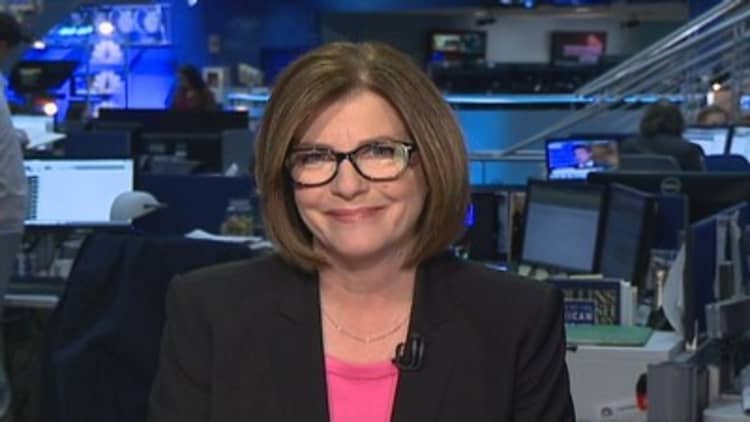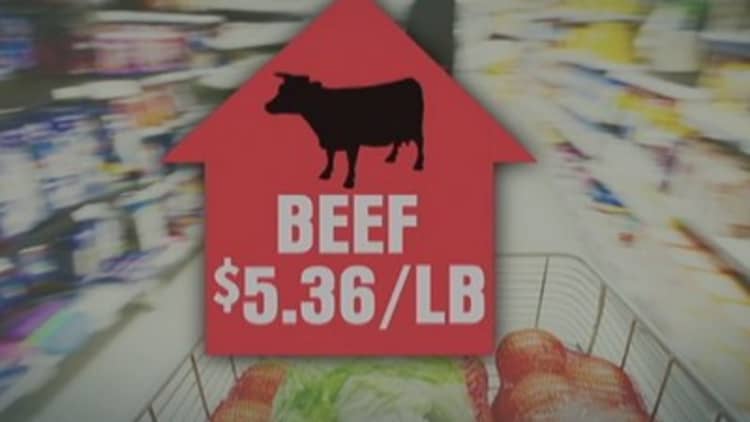Hooker Furniture said rising leather costs forced it to raise prices last quarter. Yum! Brands talked about higher-than-expected commodity inflation, and therefore, higher menu prices. Lighting company Acuity Brands said prices of some of the commodities it uses are rising and some are not, but the Georgia-based company said it's feeling the impact of higher health-care and wage costs.
All told, the management discussions this earnings season are providing a glimpse at what some analysts say the market may be quietly sniffing out—a higher rate of inflation.
"We're not talking about high inflation. We're just talking about higher inflation," said Peter Boockvar, chief market analyst with the Lindsey Group. "You saw Chipotle talking about food costs, hurting their margins and they had to raise prices."

Chipotle Mexican Grill said record high beef prices are up 25 percent since the fourth quarter, and it expects a 10 percent jump in cheese prices this year and higher avocado costs. It is raising prices companywide for the first time in nearly three years.
Read More
"I think there is some inflation pressure around," said Jack Ablin, CIO of BMO Private Bank. "Netflix had a high-profile announcement. They're starting to raise prices. I think there has been a lot of inflation pressure underneath the surface, not the least of which is coming from the job market ... whether or not that translates to broad-based price increases still remains to be seen."
(Watch this: Gasoline hits 8-month high)
While analysts say some level of inflation is healthy, rising inflation could pose a dilemma for the Federal Reserve as it winds down the stimulus from its bond-buying program. The Fed has targeted a 2 percent inflation rate as a threshold for raising short-term interest rates while also promising to keep rates low for a long time to come.
Read MoreBehind Janet Yellen's inflation dilemma
"I think it's encouraging actually," Ablin said. "As inflation expectations rise, that could encourage business to actually expand."
Gina Martin Adams, institutional equity strategist at Wells Fargo Securities, said she hasn't seen that many signs of inflation coming from corporate earnings reports, but there are other warnings. She noted there has been a sharp jump in the prices of agricultural commodities.
The Thomson Reuters/Jefferies CRB index, which includes agricultural and other commodities, is up more than 11 percent so far this year. She also noted that the five-year breakeven, or the difference between the five-year note yield and the corresponding Treasury Inflation-Protected Security has risen to just under 2 percent, though it was at that level last May.
"I guess the big risk is inflation starts to accelerate, and we really have to price in the first Fed rate hike," said Adams. Fed forecasts show rates beginning to rise in the second half of next year, for the most part. "That would be difficult for the market. ... A little bit of inflation for the economy would be a good thing."
Boockvar said the bond market may be signaling inflation in other ways. The spread between yields at the long end of the Treasury curve and the short end has flattened.

"This bear flattening really is noteworthy here. It could mean a few things. It could mean you have the short end rising in yield on the thinking the Fed is going to raise rates sooner rather than later," he said. While the two-year yield rises, the 10-year has been holding in a range around 2.70.
"On the other hand, the 10-year yield is telling me maybe the two-year is right. They think a rise in rates or a tapering is going to have a negative impact on the economy. The two-year could be responding to better economic numbers but it may also be reacting to this move in the CRB." The two-year was yielding 0.42 percent Wednesday afternoon.
Boockvar also said the expectations are for continued low inflation, so it poses more of a market risk if costs start rising more rapidly and broadly. "There's been a consensus viewpoint out there that there's no inflation, and the view from the Fed is that there's no inflation," he said.
But rising inflation expectations may be a ways off, says Deutsche Bank's chief U.S. economist, Joseph LaVorgna. For now, the outlook is for continued very low inflation, despite slightly higher CPI and PPI increases last month.
"I think as of right now, it's something you should be watching but it's too soon for any meaningful shift in inflation expectations. It is really going to be about the nonfood and energy inflation. Wage pressure will happen over time, but I don't see much evidence of wage pressure now," he said. "You don't need higher wages to get inflation. Often inflation goes up first." He did say compensation costs could be rising because of increased health-care costs.
On its earnings call, McDonald's management discussed the increase in hourly minimum wage costs that took effect in 13 states at the beginning the year.
"I think inherent in that is you do see franchisees generally around the industry, not just McDonald's, anticipating some of these higher input costs. So they've got what the states have already enacted today. They've got the discussion about a potential at the federal level. For a lot of them, the health-care mandate kicks in, in 2015 so they have to be mindful of that. So these cost pressures are definitely on everyone's mind as you think about pricing, yet ... you have to strike that right balance between everyday affordability and providing them premium products that will drive them into the restaurant," said McDonald's CFO Peter Bensen.
Oppenheimer Asset Management strategist Andrew Burkly said the stock market has already been signaling a change in expectations. He said consumer discretionary stocks—retailers and restaurants—are now the market laggards after being the market leaders last year. When that sector passes leadership to the materials sector, he says it signals a shift that margins could come under pressure.
"We've had some pretty vicious shifts in sector relative performance this year," said Adams. "I think the market is trying to price in the first fed funds hike. It's mostly in the massive breakdown in consumer discretionary ... I never want to draw any conclusions from these short-term moves but discretionary breaking down does not bode well for the market. The market typically trends sideways for six to 12 months, at best ... maybe the market is sniffing out something that we're not."
Adams said energy is also outperforming, possibly implying better pricing ahead for the sector. The S&P energy sector, as well as the industrial sector, hit an all-time high Wednesday. Oil prices have risen on concerns about tensions in Ukraine, and West Texas Intermediate was off only slightly even though a government report said oil supplies were at the highest level in 83 years.
LPL Financial's chief market strategist, Jeff Kleintop, says history shows a little inflation is good for stocks.
"Examining periods since 1950, the valuation of the stock market measured by the S&P 500 trailing price-to-earnings ratio (PR) tends to be higher when the Consumer Price Index rises above the current 1.5 percent," he wrote in a note.
"In fact, S&P 500 PEs tend to be a whole point higher than the current 16.8 when inflation is between 1.5 and 2.5 percent, a range some signs are pointing for the coming year. Only as inflation rises above 3.5 percent has it corresponded with lower PEs."
The Big Bang Theory Stock Market
| Inflation (Consumer <br> Price Index Year-Over-Year <br> Change) | P/E Multiples<br>(S&P 500 Trailing<br>Price-to-Earnings Ratio) |
|---|---|
| <-0.5 | 14 |
| -0.5-0.5 | 12.8 |
| 0.5-1.5 | 16.8 |
| 1.5-2.5 | 17.8 |
| 2.5-3.5 | 17.4 |
| 3.5-4.5 | 14.9 |
| 4.5-5.5 | 15.2 |
| 5.5-6.5 | 13.3 |
| >6.5 | 8.9 |
Source: Source: LPL Financial Research, Thomson Financial, Bloomberg 04/21/14
—By CNBC's Patti Domm. Follow her on Twitter @pattidomm.


